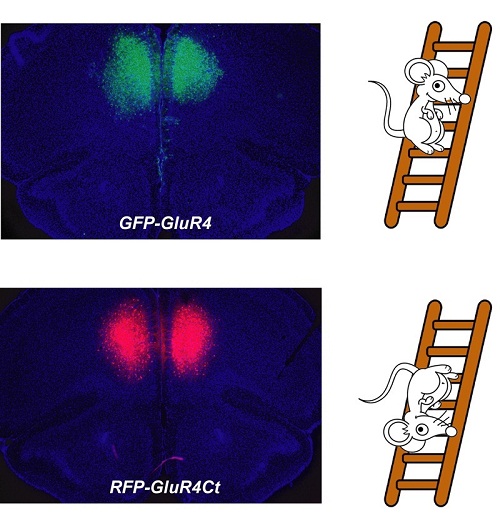Time:2011-09-30
On Sept 29, 2011, Dr. Hailan Hu’s research group at the Institute of Neuroscience, Chinese Academy of Sciences, published a research report entitled " Bidirectional control of social hierarchy by synaptic efficacy in medial prefrontal cortex " in the journal Science as Advance Online publication.
Social hierarchy is a fundamental organizing mechanism of most animal societies, and is one of the most robust forms of social behavior. The social status profoundly impacts individuals’ health and life quality. Indeed the social economic status has been identified as the single strongest predictor of health. A stable hierarchical structure is also believed to reduce unwanted intense conflicts within the group. Up to now, the neural circuit mechanism determining the social hierarchical status was almost completely unknown.
In this study, Hailan Hu’s group probed this circuitry by synaptic perturbation in the medial prefrontal cortex (mPFC), a candidate brain region explicitly implicated in social cognition. They first reliably determined the social hierarchy within groups of mice using a dominance tube test, and several other behavioral measures. Interestingly, the mouse that forced the other to retreat in the tube test also tended to gain more food, mark more territories and sing more courtship songs toward females than its subordinate counterparts. Occasionally, the dominant mouse even acted as a barber to trim off the whiskers of its cagemates. By electrophysiological recording in brain slices of dominant and subordinate mice, graduate student Fei Wang discovered that social hierarchical status correlated with the synaptic strength in mPFC neurons – The higher the rank status of the mouse, the stronger the synapses (cellular junctions where neurons communicate with each other) in the mPFC.
Using viral vectors and molecular tools, Hu’s group went on to manipulate the hierarchical status of mice by tweaking the strength of synapses in mPFC. Strikingly, subordinate mice moved up the hierarchy ladder when researchers increased their mPFC synaptic strength; conversely, dominant mice became subordinate when their mPFC synaptic strength was decreased.
This work established simple and robust behavioral paradigms for the study of social hierarchy. It opened the opportunity to a better understanding of the whole dominance circuitry. As the dominance status greatly influences many essential physiological functions including anxiety, motivation, addiction and reproduction, this work may also shed light on how these emotions and behaviors are regulated.
This work was carried out by graduate students Fei Wang, Hong Zhu and research assistants Jun Zhu, Qi Zhang and Zhanmin Lin under the supervision of Dr. Hailan Hu. The study was completed at the Institute of Neuroscience and State Key Laboratory of Neuroscience, Shanghai Institutes for Biological Sciences, Chinese Academy of Neurosciences, and supported by the 973 Program, Projects of the Scientific Research Foundation, and the Shanghai Pujiang Talent Program.

Social hierarchy is a fundamental organizing principle of social animals. In a new study, scientists discovered this is also true for the society of mice. The picture depicts the highly transitive, linear dominance relationship among a group of four mice. Art work by Fei Wang, Qi Zhang, Hong Zhu and Hailan Hu.

Using molecular manipulations in the brain, scientists can alter the way neurons communicate with each other and change the behavior of animals. This picture depicts the viral expression of a gene called GluR4 in the medial prefrontal cortex of a subordinate mouse, which resulted in its upward shift on the social ladder (top). In contrast, the expression of a gene with opposite function, GluR4Ct, led to a downward movement on the social ladder (bottom). Image provided by Fei Wang, Jun Zhu and Hailan Hu.

From left to right are authors on the paper: Qi Zhang, Jun Zhu, Fei Wang, Hong Zhu and Hailan Hu.
Website refer link:
 附件下载:
附件下载: